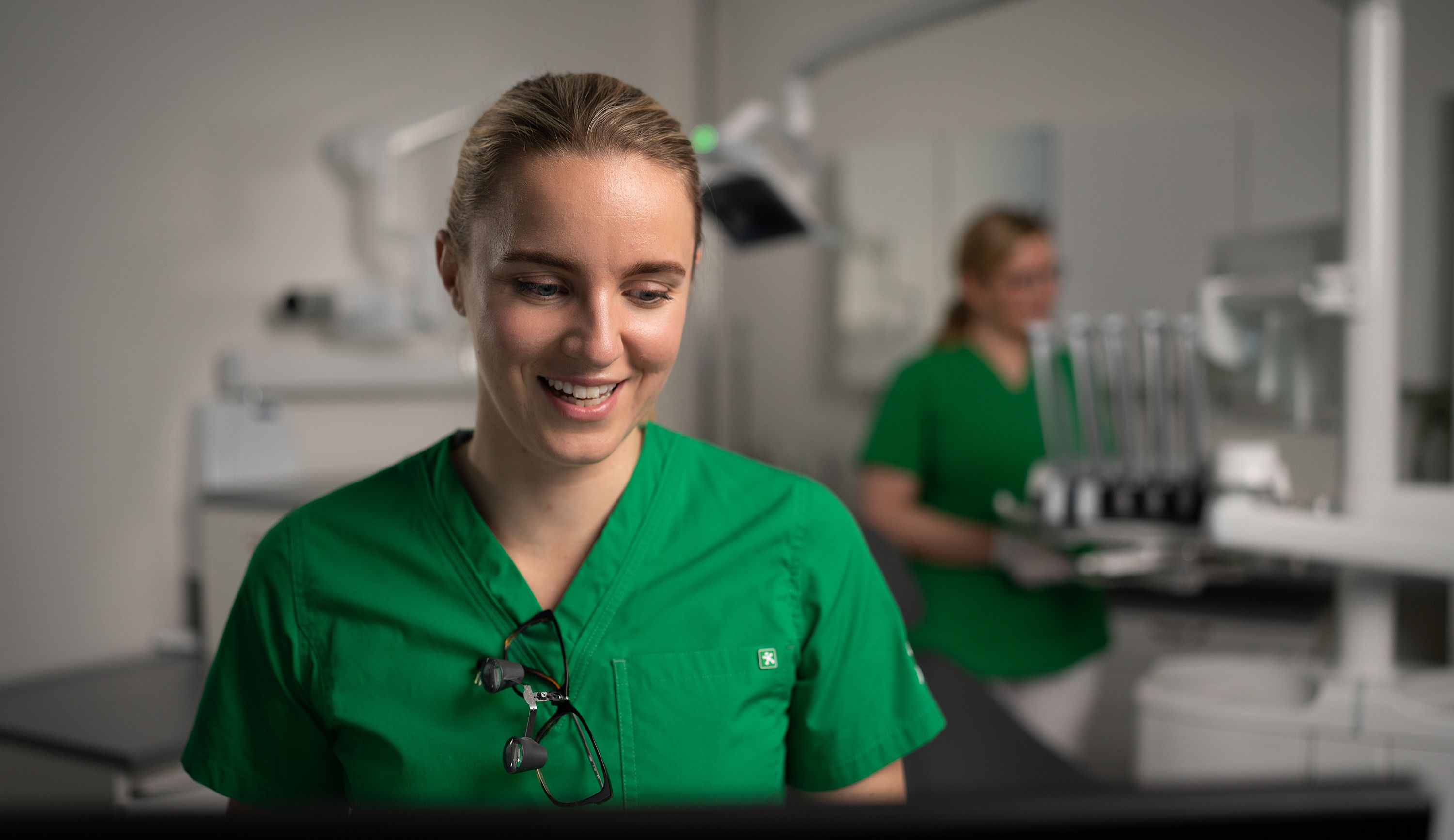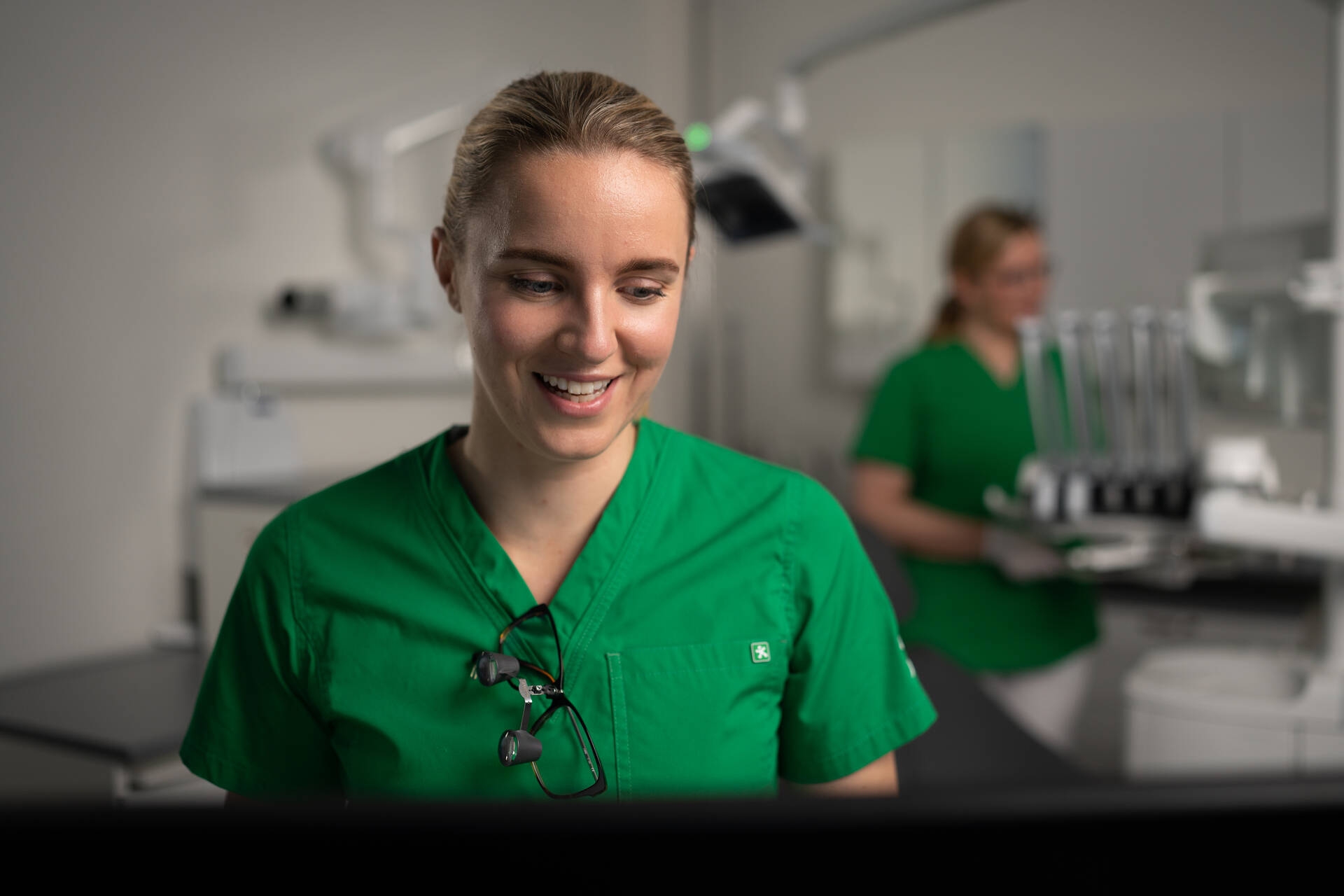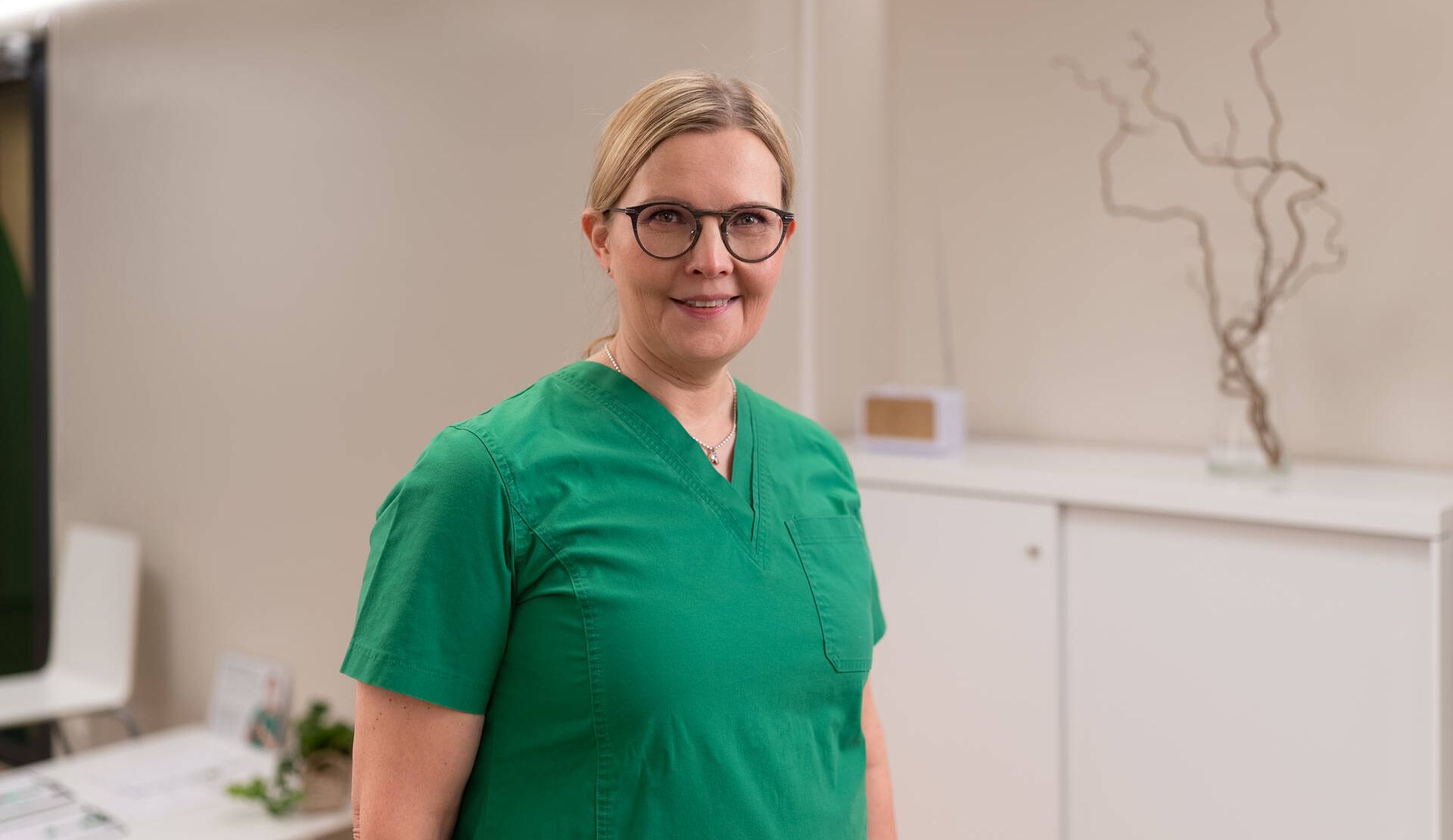
Tooth extractions are usually a quick and painless procedure
Specialist in the article

Revised 1/4/2023
Tooth extraction in a nutshell
- A tooth should be removed if it has become so bad that it cannot be repaired.
- Tooth extraction is performed under a powerful anaesthetic.
- Before tooth extraction, we will make a treatment plan with you to replace the missing tooth. Often, for bite or appearance reasons, for example, you might need a dental implant.
Related services
A dental implant replaces
Specialist dentist consultation and planning of further treatment.
Dental check-up
Assessment of oral and dental health and recommendations for further treatment.
Dental fear
Non-urgent consultation with a dentist specialized in treating patients with dental anxiety.
Wisdom tooth extraction
Wisdom teeth usually cause problems because there is not enough space for them to erupt.
When should a tooth be removed?
Sometimes, a tooth is in such bad condition that it cannot be saved. Your dentist may decide to remove a tooth if:
- the tooth is badly decayed
- there is severe gingivitis or inflammation of the root tip next to the tooth
- the root of the tooth is cracked
- the root canal treatment of the tooth has failed
- the tooth is chipped through or broken into several pieces and cannot be replaced.
How to prepare for a tooth extractions – also get help with anxiety
Tooth extraction is usually done under local anaesthesia. If you are very nervous about tooth extraction, we can help you with a sedative pre-medication.
You should take a painkiller at home an hour before the procedure. This will allow the painkiller to take effect before the anaesthetic wears off.
In the case of an extraction of an infected tooth, you may be prescribed an antibiotic an hour before the procedure in certain circumstances.
If you are having several bad teeth removed at once – i.e. dental reconstruction – and you are nervous, anaesthesia may also be considered. If you are going to be anaesthetised, you will be instructed by your anaesthesiologist well in advance.
How is tooth extraction performed?
Tooth extraction is carried out in dental surgery.
At its simplest, tooth extraction is a quick procedure: the dentist numbs your jawbone and gums, pulls a lever and pulls out your tooth - that's it.
If your tooth is chipped or has curved roots, your tooth extraction may require surgery.
After the tooth extraction, you'll take a moment to relax in the waiting room. An ice pack will be placed on your cheek to prevent swelling. We will look after you throughout your visit.
A date for a possible follow-up appointment and stitch removal will be arranged after the procedure.
You will receive home care instructions and any necessary prescriptions from your dentist before you go home. You will usually need painkillers. Removal of an infected tooth may require a course of antibiotics.
You will need an escort if you have been given a sedative pre-medication.
After tooth extraction - home care with clear instructions
In general, recovery from tooth extraction is quick. You can always get clear instructions for home care from your dentist. We will also give you a telephone number to call if you need help with any problems.
- Pain. The extraction spot may ache for two to three days after tooth extraction. After tooth extraction, the pain sometimes radiates to a wider area. You can relieve the pain with painkillers prescribed by your dentist.
- Swelling associated with a surgical extraction. Cheek swelling is not dangerous. It will go down over a few days.
- Food and drinks. Eat soft food in the days following tooth extraction. Avoid eating and drinking hot food for a day after the tooth extraction to prevent bleeding from the extraction cavity.
- Sports and other physical activities should be avoided for the day of the procedure.
- Smoking will slow down the healing of the extraction cavity.
- The extraction cavity heals best when you avoid touching it. Initially, it is a good idea to keep a roll of gauze over the extraction site for about 30 minutes. The healing of the gum after a tooth extraction depends on the person
- Complications are rare, but sometimes they can occur. Contact your dentist if the pain becomes so severe that painkillers do not help, or if the extraction cavity starts to bleed a lot, or if you develop a fever after the procedure and your cheek becomes very swollen.
What is an extracted tooth replaced with?
An extracted tooth always leaves an empty cavity – if it is visible, it is aesthetically unpleasing. Fortunately, a cavity that disturbs the appearance can be replaced immediately with a temporary denture.
Before removing a tooth, your dentist will discuss with you what to do with the empty space in your mouth. Often, a tooth that has been removed is replaced with a dental implant because of a bite or a problem with its appearance:
- For aesthetic reasons, you will probably want to replace the cavity left by the removal of a front tooth. A dental implant is often a good option for this
- Over time, the extraction of a molar can cause the neighbouring teeth to tilt towards the gap and the opposing tooth, the opposing molar, may become overcrowded. The bite will then change. To prevent this, the tooth should be replaced with either an implant or a dental bridge, depending on the situation.
As of March 15, 2023, the polyclinic fee does not have to be paid after more than five reception visits during the calendar year. After the fifth payment, the polyclinic fee is 0 € for visits for the rest of the calendar year.
The Kanta fee (3,90 €) will be charged for visits to Hammas Mehiläinen starting from January 1, 2025.
If you visit our clinic and do not pay for your appointment using the available payment methods, we will send you an invoice for your appointment. The invoicing fee is 5.20 €.
If the procedure is booked with a specialist dentist, the prices are increased by 30 %.
Check out Hammas Mehiläinen's flexible payment methods
| Service | Price estimate |
|---|---|
| Dental check-up | 54,00 € Without Kela reimbursement 84,00 € |
| Dental check-up for patients with dental fear | 91,00 € Without Kela reimbursement 121,00 € |
| Children and young people dental check-up The dental check-up performed by a dental specialist. Book a dental check-up for children and young people Prices 79,00–136,85 €, without Kela reimbursement 109,00–157,00 € | 79,00 € Without Kela reimbursement 109,00 € |
| Dental X-ray of the teeth and jaws | Mobile Benefit 88,00 € The price with a doctor's referral after Kela compensation is 79 €. 109,00 € Without Kela reimbursement 118,00 ��€ |
| Tartar removal 30–45 minute appointment with a dental hygienist. Book an appointment for tartar removal Explore different payment methods Prices 130,00–183,00 €, without Kela reimbursement 138,00–195,00 € | from 130,00 € Without Kela reimbursement from 138,00 € |
| Tooth jewellery application The price does not include the price of tooth jewellery. | from 68,00 € No Kela reimbursement |
| Dental fillings 1–3 surfaces. Prices 94,00–262,00 €, without Kela reimbursement 104,00–285,00 € | from 94,00 € Without Kela reimbursement from 104,00 € |
| Ceramic filling of the tooth 1–3 surfaces. Explore different payment methods Prices 279,00–561,00 €, without Kela reimbursement 279,00–618,00 € | from 279,00 € Without Kela reimbursement from 279,00 € |
| Dental ceramic crown Laboratory costs are not included in the price estimate. Explore different payment methods Prices 616,00–798,00 € | from 616,00 € No Kela reimbursement |
| Chipped tooth Prices 94,00–262,00 €, without Kela reimbursement 104,00–285,00 € | from 94,00 € Without Kela reimbursement from 104,00 € |
| Tooth extraction Explore different payment methods Prices 109,00–732,00 €, without Kela reimbursement 119,00–794,00 € | from 109,00 € Without Kela reimbursement from 119,00 € |
| Tooth whitening Price estimate given at the free consultation appointment. Book an appointment for a free whitening consultation. Prices incl. VAT Prices 101,00–455,00 € | from 101,00 € No Kela reimbursement |
| Whitening consultation appointment Includes an individual price estimate for teeth whitening. Book an appointment for a whitening consultation. | Free No Kela reimbursement |
| Anaesthesia Prices 38,00–39,00 €, without Kela reimbursement 41,00–42,00 € | from 38,00 € Without Kela reimbursement from 41,00 € |
| Irrevocable absence Prices 74,00–96,00 € | 74,00 ��€ No Kela reimbursement |
| Initial assessment of sleep apnea Learn more about sleep apnea and book an appointment (in Finnish) | from 57,00 € Without Kela reimbursement from 84,00 € |
| Bite guard Includes clinical work and the bite guard. Prices 638,00–685,00 €, without Kela reimbursement 695,00–742,00 € | 638,00 € Without Kela reimbursement 695,00 € |
Related symptoms
Toothache
Can be caused by a cavity or an inflamed tooth, as well as a partially erupted wisdom tooth.
Chipped tooth
A piece of a tooth or a filling has come loose. Make an appointment with your dentist.
Gingivitis
Bleeding from the gums, bad breath, bad taste in your mouth and sore gums.
Periodontitis
A common disease of the connective tissue underneath the gums which is caused by gingivitis.
Dental cavity
Can feel like an enmity or a toothache - or you don't feel anything special.
Sensitivity
Pricking and sudden pain, often caused by cold, hot or touching the tooth.
Bad breath
Often behind the smell is a problem that needs the help of a dentist.
Other related services
A dental implant replaces
Specialist dentist consultation and planning of further treatment.
Ceramic CEREC filling
More durable than conventional filling materials and a more aesthetic result.
Ceramic fillings
Modern and aesthetic ways to repair damaged teeth.
Clear aligner treatment with Invisalign aligners
Dentist consultation visit and selection of the Invisalign treatment method.
Cosmetic dental care
Can be used to alter the appearance of teeth and fix functional issues.
Dental X-ray
An important part of oral health care and an effective way to reveal oral diseases that the eye cannot detect.
Dental check-up
Assessment of oral and dental health and recommendations for further treatment.
Dental check-up for children and young people
Specialist dental check-up visit for children and adolescents.
Dental cone beam imaging
Provides highly accurate three-dimensional information on dental and jaw structures.
Dental fear
Non-urgent consultation with a dentist specialized in treating patients with dental anxiety.
Dental fillings
Filling a tooth involves removing decayed tooth tissue and replacing it with a filling material.
Dental hygienist
Provides individual advice for tending to your oral health.
Dental laminates or veneers
Can be used to correct colour defects, straighten individual teeth on the dental arch without orthodontic treatment.
Dental specialists
Are dentists who are specialised in one of the disciplines of dentistry. Specialist dentist consultation.
Dental staining removal
Dental staining removal by a dental hygienist, including soda cleaning.
Dental treatment under general anaesthesia
The most common reason for performing dental treatment under general anaesthesia is dental fear.
Dentist
Performs oral health examinations and treats oral diseases and other problems.
Dentures or false teeth
Assessment and planning of further treatment by a specialist in prosthodontics.
Emergency dental care
Emergency visit for sudden toothache, accident or other acute symptoms.
Laser teeth whitening
A gel is applied to the surface of the teeth and the effect is enhanced by light.
Massage of masticatory muscles
The massage of masticatory muscles alleviates pain in the head and jaw area.
Occlusal splints or mouth guards
Help the teeth muscles relax and protect teeth and dental structures.
Oral surgery
The examination and surgical treatment of the masticatory system and related tissues, diseases, and injuries.
Orthodontic treatment
Specialist dentist consultation to assess the need for orthodontic treatment.
Root canal treatment
The dentist treats an infected pulp of a tooth.
Sleep apnoea oral appliance
A treatment especially for mild sleep apnoea.
Tartar removal
Removal of tartar performed by a dental hygienist, including soda cleaning.
Teeth whitening
The safest and best teeth whitening is performed by a dental hygienist or dentist.
Tooth jewellery application
A dental hygienist applies tooth jewellery safely and durably.
White Spot treatment
Fading or removal of tooth discolorations.
Whitening consultation (free)
The purpose of the consultation is to identify a possible need for treatment.
Wisdom tooth extraction
Wisdom teeth usually cause problems because there is not enough space for them to erupt.
Frequently asked questions about tooth extractions
Root canal treatment can often save a tooth that is infected to the core. Tooth extraction may be a better option if:
- the tooth is cracked to the root
- the tooth is so badly decayed or chipped that it can no longer be repaired by filling
- previous root canal treatment has failed - extraction of a root canal-treated tooth is a better option
The easiest way to remove a tooth is to take just a few minutes, and with all the steps involved, you'll be ready to go home in half an hour. More demanding tooth extractions can take up to an hour to complete.
Pain after tooth extraction can last for a few days. Painkillers are effective in relieving the pain.
Your dentist will give you easy-to-follow home care instructions after the tooth extraction. Follow them and, if you have any questions, contact your dentist.
Dental implants can sometimes be placed at the time of tooth extraction. Usually, however, it is possible after about four months of tooth extraction, when the extraction cavity has been filled with bone.
After a tooth extraction, you can only eat normally once the extraction location has healed. Usually, it will heal within a few days.


